The Old Man's Beard ( Tillandsia usneoides ), and sometimes called "Spanish Moss" is one of the easiest plants to grow. It does'nt require watering , fertilising or weeding, it just survives on air, and all it really needs is somewhere to hang...a support. This plants natural habitat is as an Epiphyte in trees.... it uses the trees only for support, and gets it's nutrients and water from whatever falls on it, or blows in the wind, such as regular rain, dust , bird droppings and anything else that comes its way. This plant is a member of the Bromeliad family, which are also Epiphytes. Old Man's beard is native to the Americas - the South -East USA, and down through Central America to Argentina, and it likes an atmosphere with humidity.
Plants which grow too long can break off in the wind, and fall on to another branch, and start growing there, or alternatively, the Tillandsia spreads by seeds which develop after the tiny green flowers are pollinated. The best spot for it is under trees, in a semi-shaded position, and it dislikes cold climates with frost, so temperate to warm climate with humidity suits best.
Use some imagination and you can create some interesting garden features when growing the Old Man's Beard and you are sure to impress your Grandfather ! I took these photos in various Sydney gardens.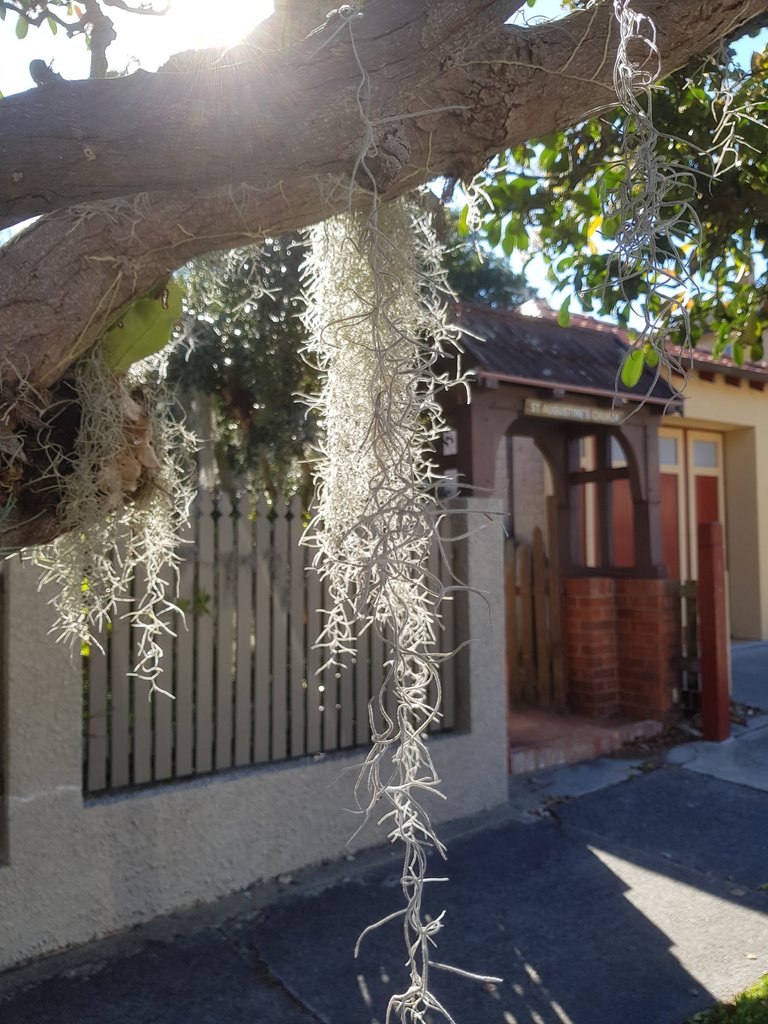
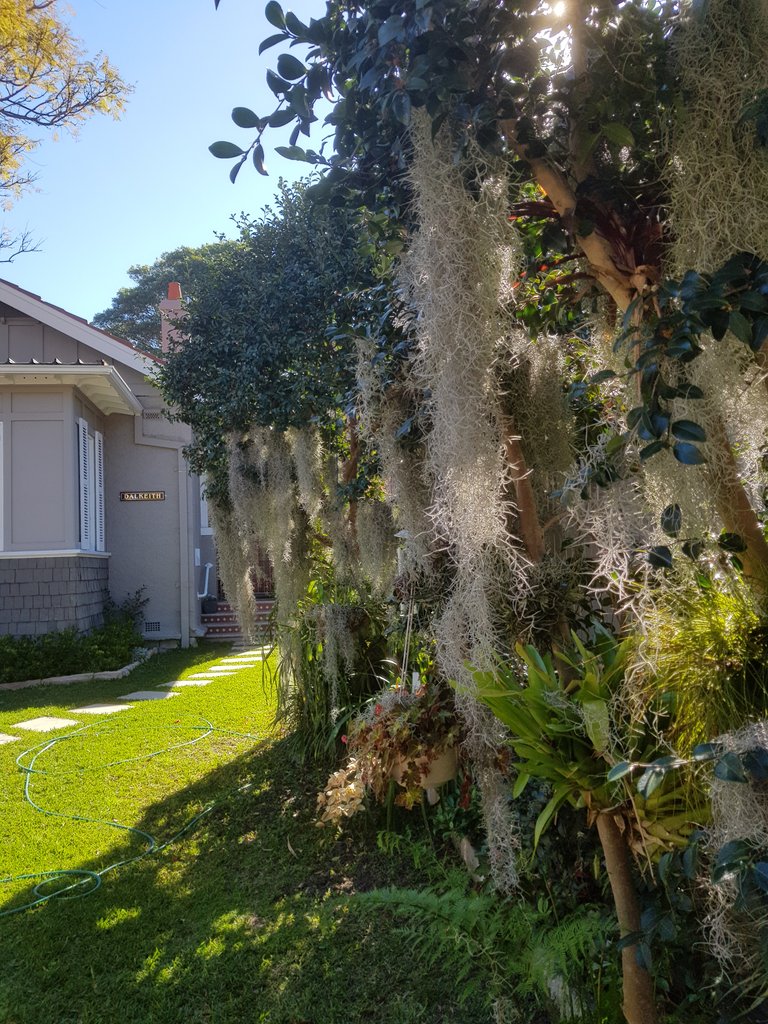
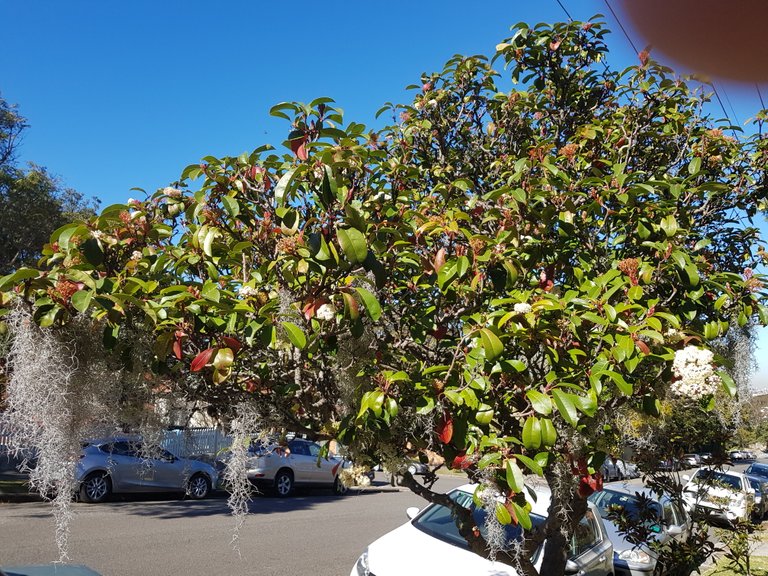
It’s that stuff that gently sways in the breeze as it drapes over the branches of an old oak tree in the South, right? But what really is Spanish moss? Is it actually Spanish? Is it actually a moss — or something else entirely? Today we’re going to take an in-depth look at the most commonly-grown air plant in the United States and find out all about its history, growth habits, and a few common uses for its foliage.
The name “Spanish moss” actually originated as “Spanish beard”. Native American tribal people called it “itla-okla”, which meant “tree hair”. Some French thought that it resembled a conquistador’s long beard and began calling it “Barbe Espagnol”, or Spanish beard. While the Spaniards retaliated by referring to it as “Cabello Frances”, or French Hair, it never caught on.
https://www.epicgardening.com/spanish-moss-tillandsia-usneoides/
Fav. comment Award ! Thanks for the excellent Pics.
Tillandsia usneoides (commonly called Spanish moss, although it is neither Spanish nor moss) is an atypical angiosperm, a primitive and xerophytic member of the Bromeliaceae. It is native to the coastal plain of the United States from Virginia to Texas and to tropical America as far south as Argentina and Chile. Its distribution may be correlated with major storm paths (Garth 1964). The blue-gray plant consists of a slender stem, up to 25 feet long, with alternating leaves growing chain-like to produce “festoons” (Billings 1904). The leaves are needle-shaped and covered with silver-gray scales. The inconspicuous fragrant flowers, which appear from April to June, are blue or pale green and have three petals. Spanish moss is dependent upon a host species or object upon which to grow. It is typically found on the branches of sparsely foliated or dead deciduous trees in high-humidity environments with soils rich in calcium carbonate (Garth 1964).
Spanish moss can grow from seeds but is typically spread by windblown fragments or from fragments incorporated in birds’ nests. This epiphyte has no roots; it captures all its water and nutrients from rain and dust in the atmosphere. Its vascular system is degenerate: Spanish moss has no functional xylem or phloem, water is absorbed by scales over the entire surface of the plant and every cell of the plant either photosynthesizes on its own or is proximal to a cell that shares resources (Billings 1904). It fixes carbon by Crassulacean acid metabolism (CAM), an adaptation to arid conditions in which carbon dioxide enters the stomata at night to reduce loss of water in its cells.
Source: http://eol.org/pages/355461/details
Fav. comment Award ! Well done for selecting great pics.
Spanish moss (Tillandsia usneoides) is an epiphytic flowering plant that often grows upon larger trees in tropical and subtropical climates, native to much of Mexico, Bermuda, the Bahamas, Central America, South America, the southern United States, French Polynesia and the West Indies and is also naturalized in Queensland (Australia). It is known as "grandpas beard" in French Polynesia.[2] In the United States from where it is most known, it is commonly found on the southern live oak (Quercus virginiana) and bald-cypress (Taxodium distichum) in the lowlands, swamps, and savannas of the southeastern United States from southeast Virginia south to Florida and west to Texas and southern Arkansas.

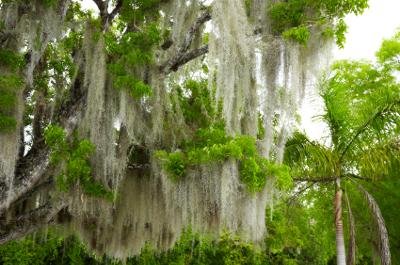
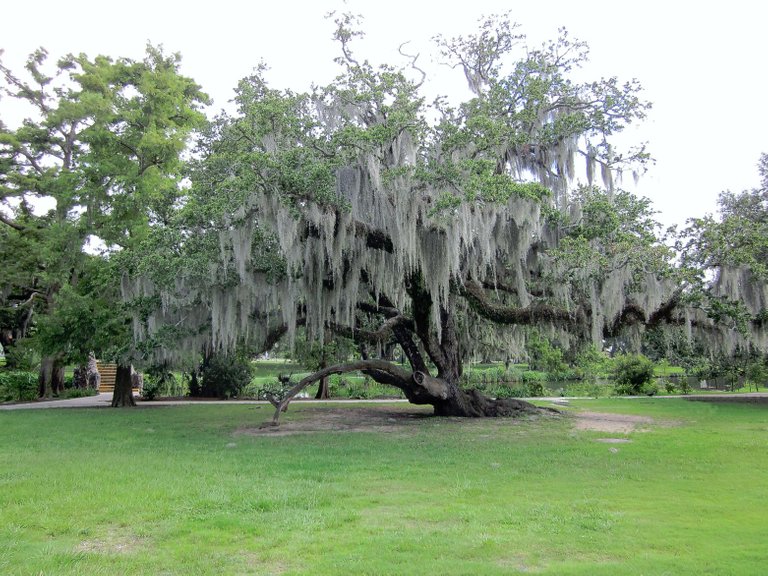

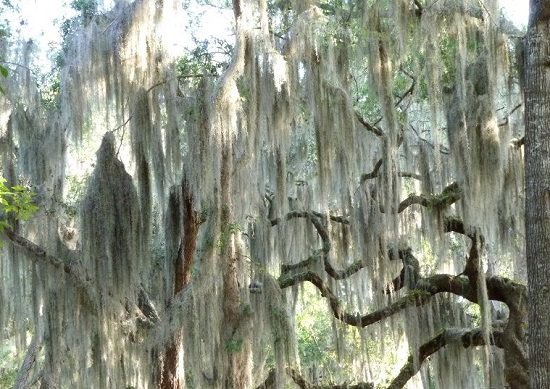
This plant's specific name usneoides means "resembling Usnea", and it indeed superficially resembles its namesake Usnea, also known as beard lichen, but in fact Spanish moss is neither a moss nor a lichen. Instead, it is a flowering plant (angiosperm) in the family Bromeliaceae (the bromeliads) which grows hanging from tree branches in full sun through partial shade. Formerly this plant has been placed in the genera Anoplophytum.
Caraguata, and Renealmia.[5] The northern limit of its natural range is Northampton County,[6] Virginia, with colonial-era reports in southern Maryland[7][8][9][10] where no populations are now known to be extant.[10] The primary range is in the southeastern United States (including Puerto Rico), through Argentina, growing where the climate is warm enough and has a relatively high average humidity. It has been introduced to similar locations around the world, including Hawaii and Australia.
Source
Silly Sausage Award ! Very nice selection of Pics.
YOU ARE HERE: HOME / LANDSCAPING / TREES & SHRUBS / HOW TO GROW SPANISH MOSS
How to Grow Spanish Moss
1 COMMENT
spanish moss growing
If you live in or have ever visited parts of the Deep South, you will likely be familiar with the gray, hairlike strands dangling from many of the trees. This eerie plant is Spanish moss. Known as “itla-okla,” or “tree hair” by indigenous Americans, Spanish moss grows on other trees to thrive. Despite its need for a host, Spanish moss is not a parasite—it is an epiphyte. The plant does not send roots into the host tree and it does not draw nutrients from the tree. Learn more about air plants.
Despite its name, Spanish moss is neither Spanish nor moss; Spanish moss is native to Mexico, Central America, the Caribbean, and parts of the southern United States from Texas to Virginia. It is considered a flowering plant, a member of the same family as pineapples and succulents. The plant is made up of slim stems with scaled leaves that grow to create a hanging structure. Although the plant produces brown, green, or yellow flowers, they are difficult to spot.
https://www.gardeningchannel.com/how-to-grow-spanish-moss/
This plant is in my country! Like you said, we are not watering it regularly! I think it use air to get water! It's beautiful and personally I like to see this plant in every garden! Like you said, semi shaded places are the well suited area for this plant to grow! Nice photography and description about this plant!@ctrl-alt-nwo,
Cheers~
Shared on twitter promoting great content on #Steemit.
It's always a pleasure to share your photographs on twitter for my followers to see.
Have a great day.
Stephen
#Promo-Steem #steemtalent #JoinSteemit #Steemit
Old Man's Beard. #STEEM #steemtalent #JoinSteemit #Steemit
#garden #gardening #gardensworld #plant #life #blog #blogger #australia #photography #photographer
Lovely plant my friend and Tillandsia usneoides is a flowering plant that grows upon larger trees, commonly the Southern Live Oak (Quercus virginiana) or Bald Cypress (Taxodium distichum) in the south-eastern United States. It grows hanging from tree branches in full sun or partial shade. Its natural range is from Virginia Beach, Virginia in the south-eastern United States to Argentina, growing wherever the climate is warm enough and has a relatively high average humidity. It has been introduced to similar locations around the world, including Hawaii and Australia.
While it rarely kills the trees, it lowers their growth rate by reducing the amount of light to a tree’s own leaves. It also increases wind resistance, which can be fatal to the host tree in a hurricane. In the southern United States, the plant seems to show a preference of growth on Southern Live Oak (Quercus virginiana) or Bald Cypress (Taxodium distichum) because of these trees’ high rates of foliar mineral leaching (calcium, magnesium, potassium, and phosphorus) providing an abundant supply of nutrients to the plant, but it can also colonize other tree species such as Sweetgum (Liquidambar styraciflua), crepe-myrtles (Lagerstroemia spp.), other oaks and even pines.
Tillandsia usneoides is an epiphyte which absorbs nutrients (especially calcium) and water from the air and rainfall.
The plant consists of a slender stem bearing alternate thin, curved or curly, heavily scaled leaves 2–6cm (0.79–2.4 inch) long and 1mm (0.039 inch) broad, that grow vegetatively in chain-like fashion (pendant) to form hanging structures up to 6m (240 inch) in length. The tread-like stems covered with grey scales are in reality, minute, scaly leaves. The plant has no aerial roots and its flowers are tiny and inconspicuous. The tiny, pale green flowers that appears in the leaf axil of wild Tillandsia usneoides, rarely bloom on plants grown indoors. The flowers, with a musk fragrance, appear in the warmer months.
Thank you @ctrl-alt-nwo
A source of information: http://www.plantsrescue.com/tillandsia-usneoides/
That one is really beautiful!!
in my part, i like more the vegetables / fruits plants than the ornamental ones
Amazing plant @ctrl-alt-nwo! Spanish moss is neither from Spain nor a moss; it is an epiphytic member of the pineapple family from the Americas. Epiphytes are plants growing on other plants from which they derive no nutrients. Across its native range, from southeastern North America through Central and South America as far south as Argentina and Chile, it is a common sight draped over trees in high humidity areas. There is even evidence that the distribution of Tillandsia usneoides is correlated with the damage created by major storms. Carolus Linnaeus' use of the specific name, usneoides (Usnea-like), refers to the plant's superficial morphological and ecological similarity to the lichen genus Usnea, which is a symbiotic relationship between a blue-green alga and a fungus.
Tillandsia usneoides is rootless, consisting of narrow, alternate leaves arranged along a slender, wiry, silvery blue-green stem. Tillandsia usneoides lacks an extensive vascular system but is covered in tiny, water-absorbing scales; all the plant's water and nutrient needs are derived from rain, dust and detritus. Since Tillandsia usneoides gets all of its nutrients from the atmosphere it has been extensively investigated as a monitor for heavy metal pollution in urban areas.
In addition to morphological adaptations, Tillandsia usneoides shows a specific biochemical adaptation to growth in arid conditions, where water resources are likely to be limited; atmospheric carbon dioxide is fixed by a modification of photosynthesis called Crassulacean Acid Metabolism (CAM). In CAM photosynthesis, stomata (pores in plant surfaces) open at night; carbon dioxide enters the plant, where it is converted to organic acids. During the day, when the stomata are closed, the organic acids are transformed back to carbon dioxide and the normal machinery of photosynthesis converts carbon dioxide and water into sugars.
The biology of Tillandsia usneoides means it is a good disperser. Vegetative propagation occurs by stem fragments being carried by the wind or by birds; new plants readily growing from pieces trapped on trees or telegraph wires. The small, insect-pollinated flowers of Tillandsia usneoides have blue-green petals, but are frequently overlooked. When ripe fruit capsules open, small, flat, hairy, wind-dispersed seeds are released.
Human uses of this curious plant are limited. Stem fibres have been used by Native American cultures for weaving and rope-making, whilst whole plants, mixed with clay, have been used as daub, as medicine and even as animal fodder. Today, Tillandsia usneoides is most familiar as packing material or as a house plant.
A source: https://herbaria.plants.ox.ac.uk/bol/plants400/profiles/ST/Tillandsia
Spanish moss (Tillandsia usneoides) is an epiphytic flowering plant that often grows upon larger trees in tropical and subtropical climates, native to much of Mexico, Bermuda, the Bahamas, Central America, South America, the southern United States, French Polynesia and the West Indies and is also naturalized in Queensland (Australia). It is known as "grandpas beard" in French Polynesia. In the United States from where it is most known, it is commonly found on the southern live oak (Quercus virginiana) and bald-cypress (Taxodium distichum) in the lowlands, swamps, and savannas of the southeastern United States from southeast Virginia south to Florida and west to Texas and southern Arkansas.

.png)
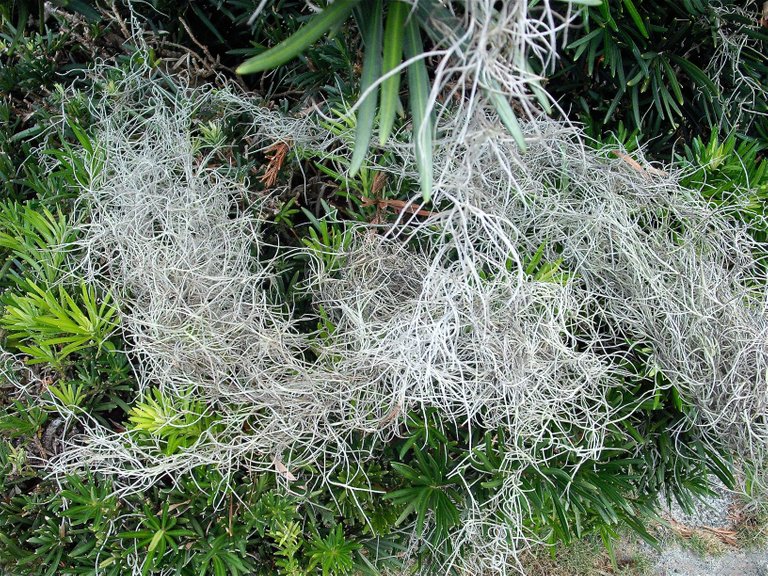
Source
Source
Source
This plant's specific name usneoides means "resembling Usnea", and it indeed superficially resembles its namesake Usnea, also known as beard lichen, but in fact Spanish moss is neither a moss nor a lichen. Instead, it is a flowering plant (angiosperm) in the family Bromeliaceae (the bromeliads) which grows hanging from tree branches in full sun through partial shade. Formerly this plant has been placed in the genera Anoplophytum, Caraguata, and Renealmia. The northern limit of its natural range is Northampton County, Virginia, with colonial-era reports in southern Maryland where no populations are now known to be extant. The primary range is in the southeastern United States (including Puerto Rico), through Argentina, growing where the climate is warm enough and has a relatively high average humidity. It has been introduced to similar locations around the world, including Hawaii and Australia.
Source
close your name of my list @msena
Thank you, I'm glad that you understand.
Quite a nice plant to give our trees some highlights @ctrl-alt-nwo and people sometimes wonder what are those beard-looking thing that hangs like beard or grey hair.
This is amazing! We also call this plant a beard, but a yogi’s beard! I have seen some growing very long from old trees. Mine are still about one meter long. The wind keeps breaking them off into small pieces!
Cheers.
Posted using Partiko iOS
An interesting and unusual plant, widely distributed in subtropical and tropical regions of the Americas, from the southern states of the United States to Argentina and Chile. This type of aero plant is one of the most common and has several synonyms for the name: “Spanish moss”, “Louisiana moss”, “Old man’s beard”. Indeed, thanks to scales, foliage and stems have a grayish-gray color, grow and branch out rather quickly, and resemble a gray beard. The official name also has an explanation: the color of the plant is similar to the Usney lichen.
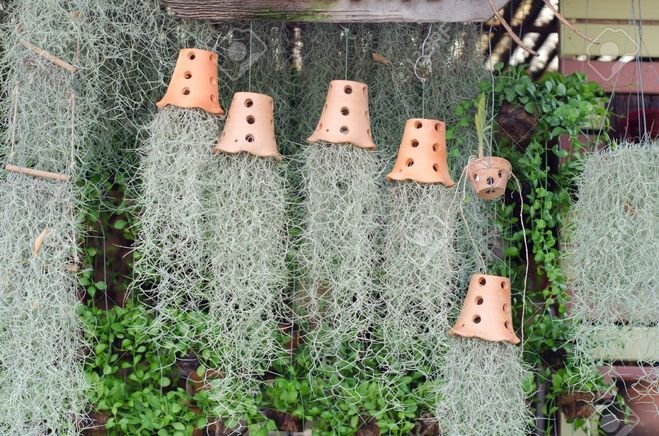
Tillandsia stems are covered with whitish fuzz, grow up to 20 cm, but young shoots appear on old shoots, thus, the total length of a plant can reach 3 m and more. The leaves are narrow, about 1 mm wide and up to 5 cm in length. All surfaces are covered with small scales, the main purpose of which is to absorb moisture and nutrients from the atmosphere.
Flowering occurs in July and August. The inflorescence is inconspicuous, yellowish-green, the flowers are small. I have not met such a plant, I learned about it from you. Thank you very much :)
http://www.bolshoyvopros.ru/questions/2873224-ispanskij-moh-chto-za-komnatnoe-rastenie.html
Description

Spanish moss is gray when dry and light green when wet, and it hangs from tree branches in wind blown festoons that may reach 20 ft (6 m) or more in length. The stems and leaves are slender and curly, and covered with tiny silvery-gray scales that catch water and nutrients (in dust particles) from the air. Spanish moss has no roots. The flowers are inconspicuous, pale green or blue, and fragrant at night. Spanish moss is not related to mosses at all, but is in fact closely related to the pineapple and other bromeliads or "air plants."
Usage


Spanish moss is not a parasite. That is, it does not take nutrients or water from the host tree on which it lives. However, occasionally, Spanish moss can become so thick that it shades the leaves of its host, or, when heavy with rainwater, breaks a branch. Although a tree might be weakened, it would not likely be killed by Spanish moss. However, it is considered a pest in pecan orchards.
Spanish moss makes a great mulch if you're lucky enough to garden within its range. It is often used in decorative floral arrangements and handicrafts. I sent my mother in upstate New York some home grown kumquats packed in Spanish moss and she was more excited about the packing material than my North Florida citrus! Spanish moss is sometimes hung on fences or wires to create privacy screens.
Features

The suffix, "-oides" on many scientific names means "similar to", and in this case refers to the similar looking, but unrelated, lichen, Usnea, or old man's beard, which also is an epiphyte on tree limbs.
For more than two centuries Spanish moss was harvested commercially, and tons of it were shipped to Detroit for use in automobile seats and to other cities in America and Europe for mattress and furniture stuffing. It was said to make the coolest mattresses, an important consideration in the days before air conditioning.
References12345
Tillandsia is an ornamental plant that has the Latin name Tillandsia usneoides, whereas in the United Kingdom, where people first discovered this type of plant, tillandsia is called a spanish mass.
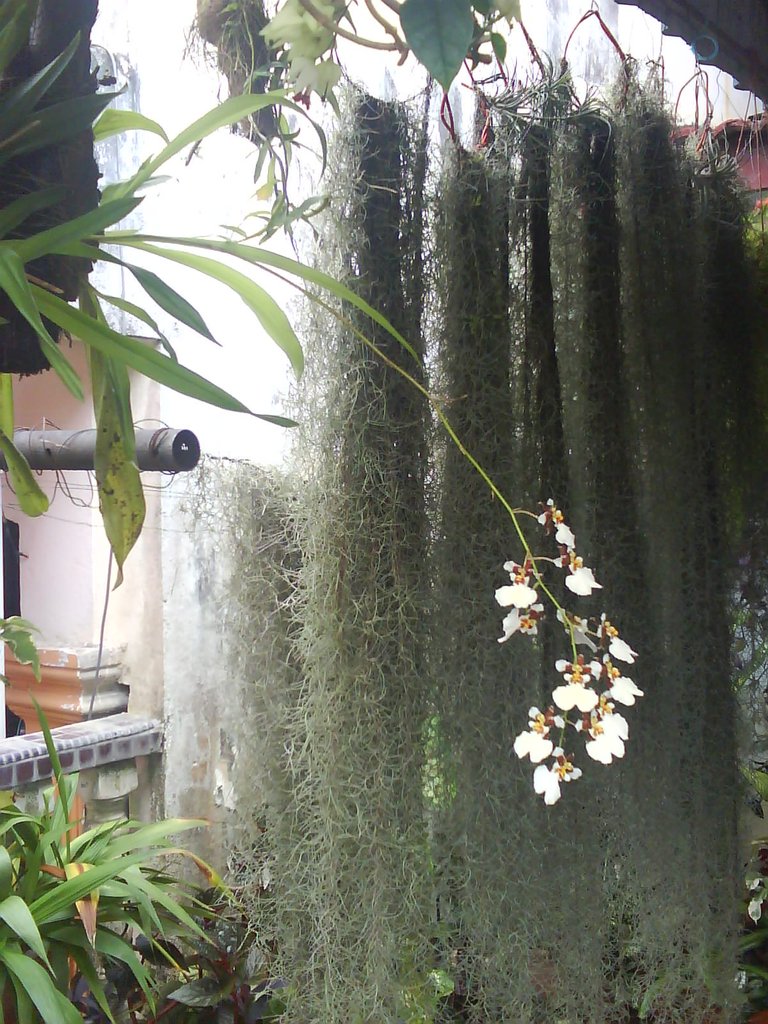
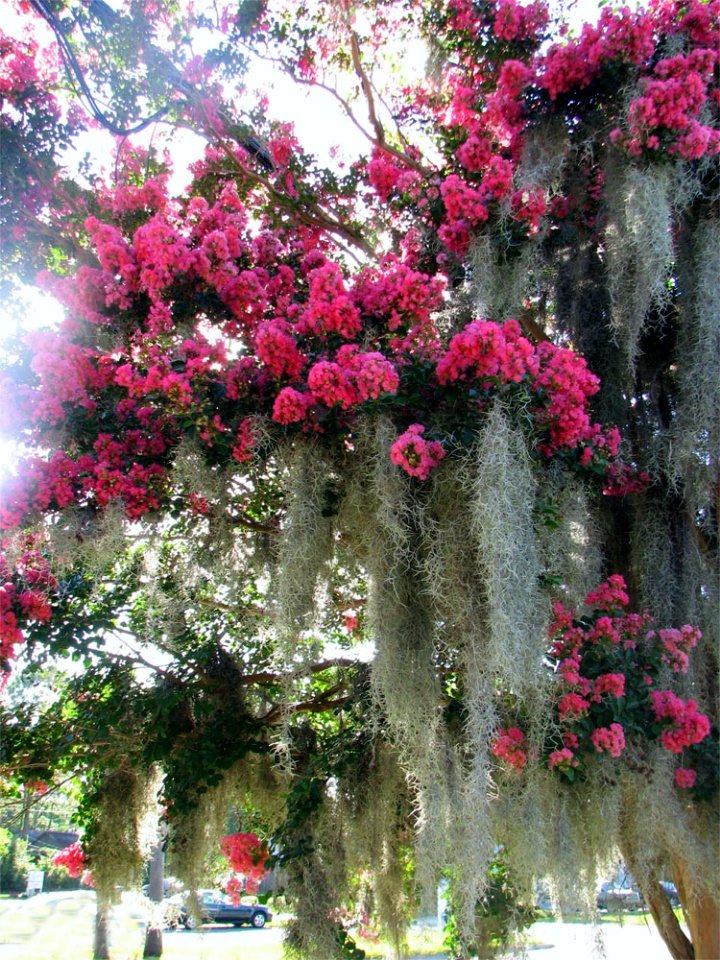
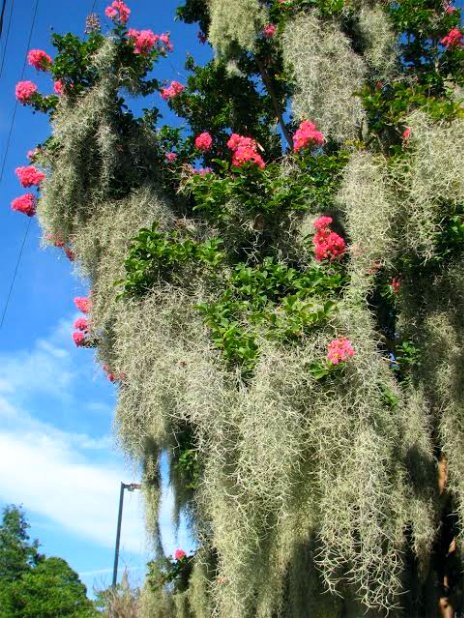
In its natural habitat, live tillandsia propagates and attaches to large trees such as parasites. The shape of the tillandsia plants is like tangled and irregular threads. To make it an ornamental plant, we must cut and wait for it, and plant it in hanging pots so that the plants will grow beautifully and dangle like curtains. Not surprisingly, lovers of this plant, in general, made it tillandsia as a curtain covering the porch of the house.
Another uniqueness of this plant is the color that can change. If these tillandsia plants are placed in a hot place, the color will become greenish white. Whereas if this plant is placed in a cool or cool place, the color will turn green.
Based on its uniqueness, tillandsia plants which include hanging plants are very suitable to decorate the porch of the house. Aside from being an ornamental plant, the presence of tillandsia plants on the porch of the house can function as a conditioning or direct sunlight barrier into the house, as well as a barrier or reduce pollution from dust that pollutes the terrace of the house.
Source:
https://www.google.co.id/url?sa=t&source=web&rct=j&url=http://legalstudies71.blogspot.com/2015/10/tillandsia-janggut-nabi-dan-cara.html&ved=2ahUKEwiIjMGe1a_eAhVKVH0KHbIvCq4QFjAhegQIBBAB&usg=AOvVaw0Wu8Ohu5zBJCfvwiHsGlIt&cshid=1540954455854
Spanish moss, also called Black Moss, Long Moss, orVegetable Horsehair, (Tillandsia usneoides), epiphyte (a nonparasitic plant that is supported by another plant and has aerial roots exposed to the humid atmosphere) of the pineapple family (Bromeliaceae). It is found in southern North America, the West Indies, and Central and South America.
The silvery-gray plant often grows in large, beardlike masses. It has threadlike stems up to 6 to 7.5 metres (about 20 to 25 feet) long. The leaves, also threadlike, are about 2.5 to 7.5 centimetres (1 to 3 inches) long. The yellow flowers, which appear rarely, are stalkless, have three yellow petals, and three sepals, and usually grow singly. Hairlike scales that cover the whole plant absorb water from the air. Spanish moss sometimes is used as a filler in packing boxes and as upholstery.
https://www.britannica.com/plant/Spanish-moss
The natural way of nature beard that's so cool never seen that before
Interesting needs she has. If we translate it to our language she needs more stable and emotional love, not so much after resources :-)
Yeah, if only more of them were like that !
I just love this kind of plants
Congratulations @ctrl-alt-nwo! You have completed the following achievement on the Steem blockchain and have been rewarded with new badge(s) :
Click here to view your Board of Honor
If you no longer want to receive notifications, reply to this comment with the word
STOPDo not miss the last post from @steemitboard:
Your post was mentioned in the Steemit Hit Parade in the following category:Congratulations @ctrl-alt-nwo!
The Old Man's Beard ( Tillandsia usneoides ). plants and also Informative to know that these plants doesn't need the Water and live on the basis of Air. And yes, it's purely reflecting as Beard Of Old Man or Ancient Man. And most importantly these plants can become the hanging decorative pieces. And sometimes i think that we just explored cent percent of the nature's creations and there are unlimited aspects which we have to see. And whenever i see these kind of the creations then it inspires me to know more towards those subjects which i am not aware yet and nature is an surprising aspect for sure.@ctrl-alt-nwo, Great to know about this
Wishing you an great day and stay blessed. 🙂
I've never even heard of this plant.
Great photos, @ctrl-alt-nwo
Thank you that told about the wonderful
the old man's beard - Tillandsia usneoides
source
interesting name and really does resemble it haha.
Congratulations @ctrl-alt-nwo! You have completed the following achievement on the Steem blockchain and have been rewarded with new badge(s) :
Click here to view your Board of Honor
If you no longer want to receive notifications, reply to this comment with the word
STOPDo not miss the last post from @steemitboard:
Great plant. It is immediately clear why he has such a name. Very similar to a long beard.
Spanish moss is a superb 'air plant' which grows in silverish festoons up to 30 m long, hanging from tree limbs, cliffs and even telephone wires. Tillandsia usneoides prefers moist habitats and is often abundant near rivers, ponds and lakes.
It can survive two months without rainfall but will die within three to four months of drought. In dark forest it hangs suspended from the higher limbs of trees (most commonly on trees that are dead).
Spanish moss possesses striking adaptations to its environment. The entire surface of the shoot is covered with highly specialised trichomes (scales) which absorb water and nutrients from the atmosphere; they also reduce transpiration and reflect strong light. Tillandsia usneoides prefers moist habitats and is often abundant near rivers, ponds and lakes. It can survive well in dry habitats too, through Crassulacean acid metabolism (CAM), a specialised way to photosynthesise.
It can survive two months without rainfall but will die within three to four months of drought. In dark forest it hangs suspended from the higher limbs of trees (most commonly on trees that are dead). T. usneoides grows on a wide range of trees, both wild and cultivated, which have a high rate of mineral leaching. It does not appear to favour any hosts. Many tropical trees, however, release chemicals making conditions unfavourable for the growth of Spanish moss.
Source
What an interesting story about this plant
Usilliform tillandsia is a flowering plant of the Bromeliad family. The roots of the plant are fixed on the bark of trees, but do not feed on its juices, like the plants of parasites, but receive water from the surrounding moist tropical air. The plant has thin stems, gray-green or gray-blue in color, 20-30 cm high. Dying stems can exceed three-four meters in length, they hang down with a fancy beard.
The indigenous people of South America, the Indians, first saw the bearded faces of Spanish sailors, compared their beards with this plant. And they began to call it moss because of the external similarity with usne moss. Tillandsiya - in honor of the botanist E. Tillands, who described the plant in the 17th century. This is how the flowering plant Tillandsia, usneideal or Spanish moss, was called. Also, the angel's hair and the beard of an old man are also Spanish moss. The plant blooms with small flowers, the fruit has a box, the seeds are very small.
The plant is perfectly adapted to receiving moisture from the air, and not from the soil. The whole stem has peculiar outgrowths - scales, which catch both dew and rain moisture.
The tillandsia is multiplied with the vagina and by seeds and vegetatively.
Pieces of the stem and seeds are captured by wind and rainwater and spread from tree to tree. Spanish moss especially likes oaks and cypresses, but it can even live on an electric pole. Many species are listed in the Red Book.
For a freakish look, tillandsy fell in love with fans of room floriculture.
http://ogorodsadovod.com/entry/2234-volosy-angela-boroda-starika-ispanskii-mokh-ili-tillandsiya-usneevidnaya
Spanish moss (Tillandsia usneoides) is a member of a group of bromides called air plants. These plants have no roots, and absorb all the moisture and nutrients they need through specialized scales on their stringy leaves. Outdoors, Spanish moss gets its nutrients from dust and detritus in the air and grows in U.S. Department of Agriculture plant hardiness zones 9 to 11. These unusual plants are grown indoors as accents on driftwood, rocks or other decorative items. Although the flowers are inconspicuous and not particularly attractive, they have a pleasant fragrance.

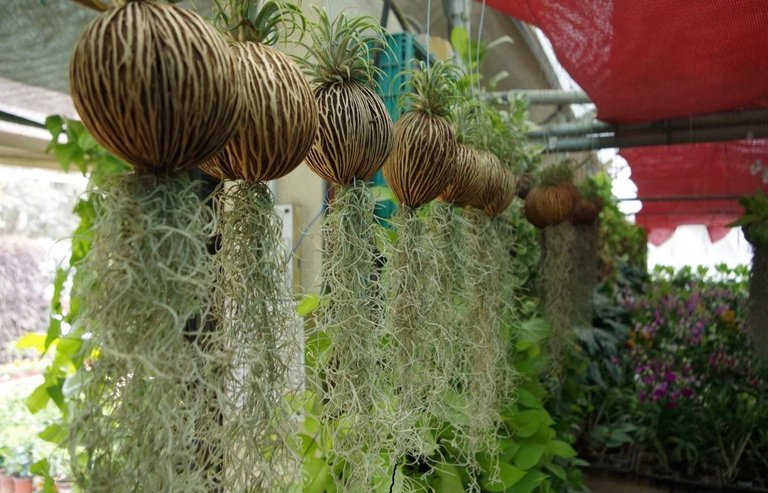
image source
image sources
Spanish moss collected from outdoors is almost always infested with tiny insects, especially red bugs. Treat it with insecticide before bringing it into your home.
content source
Tillandsia usneoides (L.) L. (Bromeliaceae)
.
Spanish moss
Spanish greenery is neither from Spain nor a greenery; it is an epiphytic individual from the pineapple family from the Americas. Epiphytes are plants developing on different plants from which they infer no supplements. Over its local range, from southeastern North America through Central and South America as far south as Argentina and Chile, it is a typical sight hung over trees in high moistness territories. There is even proof that the dispersion of Tillandsia usneoides is corresponded with the harm made by real tempests. Carolus Linnaeus' utilization of the particular name, usneoides (Usnea-like), alludes to the plant's shallow morphological and natural closeness to the lichen variety Usnea, or, in other words connection between a blue-green alga and a parasite.
Tillandsia usneoides is rootless, comprising of thin, exchange leaves masterminded along a slim, wiry, shiny blue-green stem. Tillandsia usneoides does not have a broad vascular framework however is shrouded in small, water-retaining scales; all the plant's water and supplement needs are gotten from rain, residue and rubbish. Since Tillandsia usneoides gets the majority of its supplements from the air it has been broadly examined as a screen for overwhelming metal contamination in urban zones.
Notwithstanding morphological adjustments, Tillandsia usneoides demonstrates a particular biochemical adjustment to development in parched conditions, where water assets are probably going to be restricted; environmental carbon dioxide is settled by a change of photosynthesis called Crassulacean Acid Metabolism (CAM). In CAM photosynthesis, stomata (pores in plant surfaces) open around evening time; carbon dioxide enters the plant, where it is changed over to natural acids. Amid the day, when the stomata are shut, the natural acids are changed back to carbon dioxide and the typical hardware of photosynthesis changes over carbon dioxide and water into sugars.
The science of Tillandsia usneoides implies it is a decent disperser. Vegetative engendering happens by stem parts being conveyed by the breeze or by flying creatures; new plants promptly developing from pieces caught on trees or broadcast wires. The little, creepy crawly pollinated blossoms of Tillandsia usneoides have blue-green petals, yet are oftentimes ignored. At the point when ready organic product cases open, little, level, bushy, wind-scattered seeds are discharged.
Human employments of this inquisitive plant are restricted. Stem strands have been utilized by Native American societies for weaving and rope-production, while entire plants, blended with earth, have been utilized as smear, as medication and even as creature grub. Today, Tillandsia usneoides is most recognizable as pressing material or as a house plant.
https://herbaria.plants.ox.ac.uk/bol/plants400/profiles/ST/Tillandsia
From a distance it looks like frost :)
A wonderful composition of old age (beard ^^ ) with a juicy tree (amazing greenery).
Have a wonderful day full of inspirations
Greetings
It looks so beautiful! I enjoy it!
Hello @ctrl-alt-nwo, nice to meet you. introduce my name is @aulia1993 from Indonesia. this is my first time visiting your blog. that's why I want to introduce myself first. I have followed your post that discusses the Spanish Moss plant.
this is my first time seeing plants like this. plants that have no leaves, and can grow easily. in my opinion this is one of the wild plants. because it can grow anywhere. I became more curious about plants like this. I will visit Geogle to find out more about this plant.
magoo-2 found a series of multi accounts of a same owner is following your articles to cheat your generous rewards.
magoo-2 found these accounts are suspicious & can be multi accounts of a single owner. Conclusion is based on last 1 year transactions:
@aulia1993 @post-healt
magoo-2
Check our latest multi comment spam update report
Hello @magoo-2 . You have repeatedly made comments like this to me. @post-heal is indeed my account. but the account has long been deactivated. why do you accuse someone without checking first.
If you want to grow Spanish moss in your home, the best way to keep it alive and healthy is to mimic its natural environment.
Spanish moss is not actually a type of moss but an epiphytic Bromeliad also known as an air plant. It grows on trees in a non-parasitic manner, relying on raindrops and humid air as its natural water sources. In the home, this means you don’t need a pot to grow Spanish moss: just place the moss near a window that offers bright, indirect light. A relatively warm and humid location is ideal.
SX425.jpghttps://images-na.ssl-images-amazon.com/images/I/6167qsDCKpL.
source
The world's easiest plant to grow.
Spanish moss has to be the world's easiest plant to grow.
Also called old man’s beard or, if you want to get technical, Tillandsia usneoides, Spanish moss is in the bromeliad family, though you’d never guess that by its looks, and it’s a native of the Americas – from the south-east of the United States right down through Central America to Argentina.
Spanish moss always grows on the branches of trees and shrubs, but it’s not a parasite. It just hangs over them, growing longer and longer. When the wind gets up, bits of it break off and, if that part is blown onto another branch, it starts to grow there. It also reproduces from seeds produced after the tiny, greenish flowers are pollinated.
With no roots Spanish moss has to absorb all its moisture and food through its leaves. Rain supplies both water and some dissolved nutrients and there is always the odd bird or animal dropping and wind- blown dust to help sustain it.
Routine care
In eastern Australia the rainfall and humidity of an average summer easily sustains Spanish moss.
Mist with water only during dry spells or if hot, dry weather or hot winds are predicted.
You don’t have to feed it, but if you want to, mist it with a very, very, very weak fertiliser solution.
Hot tip
When transferring to another branch, grab a handful of strands not just a few. It gets going faster that way.
Source
This plant (Tillandisa) is well known as a good plant. There is even evidence that the distribution of Tillandsia usneoides is correlated with the damage created by major storms.
Tillandsia usneoides is rootless, consisting of narrow, alternate leaves arranged along a slender, wiry, silvery blue-green stem.
The biology of Tillandsia usneoides means it is a good disperser. Vegetative propagation occurs by stem fragments being carried by the wind or by birds;
This name is the accepted name of a species in the genus Tillandsia (family Bromeliaceae).
The record derives from WCSP (data supplied on 2012-03-23) which reports it as an accepted name (record 269929) with original publication details: Sp. Pl. ed. 2 411 1762.
Full publication details for this name can be found in IPNI: http://ipni.org/urn:lsid:ipni.org:names:1169665-2.
Synonyms:
See "Status", "Confidence level", "Source" for definitions.
source
Hello sir ..........



It is the lovely plant and easiest to grow....
Those who like to make Thier garden more beautiful they
Can do very easily .....check these pictures how it is useful
To increase beauty and it is new..
Check it out sir it is hanging..
And it is tricky but for those who Love thier garden it is amazing..
I hope you like my opinion
Magoo-2 found a series of multi accounts of a same owner is following your articles to cheat your generous rewards.
Magoo-2 found these accounts are suspicious & can be multi accounts of a single owner. Conclusion is based on last 30 days transactions:
@abdt @wolf-kinght @sardar-sani
magoo-2
Check our latest multi comment spam update report
The so-called Spanish moss is actually an epiphytic bromeliad, originating in Southern USA, Central and South America, and the West Indies! It was once used to stuff pillows and furniture. It has no roots, and the branching wiry stems bear fine leaves covered with silvery white scales. The strands will grow on tree branches and in time form thick masses, which can become quite lengthy and can be used to create interesting garden effects or even a living screen. Apparently, Spanish moss was used by rural people in the southern United States to fill pillows and mattresses, and has been used as stuffing for upholstery.
source
Family Name : Bromeliaceae
Synonyms : Abromeitiella usneoides, Tillandsia usneoides f. genuina, Abromeitiella usneoides, Abromeitiella usneoides Common Names : Spanish Moss, Old Man's Beard, Long Moss, Black Mosssource
magoo-2 found a series of multi accounts of a same owner is following your articles to cheat your generous rewards.
magoo-2 found these accounts are suspicious & can be multi accounts of a single owner. Conclusion is based on last 1 year transactions:
@kheightces @thytheso @mabir @ristotle @tanuesh @alizamanjutt454 @eastmund @vijayar @lycusa @snorio @alexeyy @surenda @isuru1127
magoo-2
Check our latest multi comment spam update report
illandsia usneoides (L.) L.
Common Names: Spanish Moss, Old Mans Beard
Family: Bromeliaceace
Habit: Tillandsia usneoides grows as an epiphyte as a series of hanging connected plants. The leaves are covered with gray lepidote scales. The base of 2-3 leaves forms a pseudobulb/stem less than 1 mm in diameter. The leaves are to 8 cm in length, without a distinction from leaf base to leaf, with an acuminate leaf apex and entire margin.
The actinomorphic, complete, perfect flowers are arranged solitarily in leaf axils, each subtended by a bract. The greenish bract is linear to ovate with an acute or apiculate apex and is equal to or shorter than the length of the calyx. There are 3 green unfused sepals in the calyx. There are 3 light blue, unfused petals in the corolla. There are 6 stamens that are not longer than the petals. The ovary is superior with 3 locules and numerous seeds. The fruit is a capsule. Each seed has a tuft of hair to assist in dispersal.
source
magoo-2 found a series of multi accounts of a same owner is following your articles to cheat your generous rewards.
magoo-2 found these accounts are suspicious & can be multi accounts of a single owner. Conclusion is based on last 1 year transactions:
@kheightces @thytheso @mabir @ristotle @tanuesh @alizamanjutt454 @eastmund @vijayar @lycusa @snorio @alexeyy @surenda @isuru1127
magoo-2
Check our latest multi comment spam update report